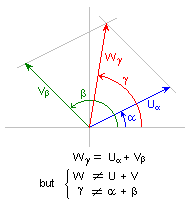|
ACTIVITY 3.10 |
|||
|
To make this sum, we do not have more remedy than start by calculating his components:
make the sum: |
 |
and finally, if we want to give the result in polar form, calculate the module and the argument of the sum:

(You think about adding 180 º to Atan if![]() +
+![]() It is in the 2nd or 3rd quadrant, that is to say, if the 1rst component of
It is in the 2nd or 3rd quadrant, that is to say, if the 1rst component of![]() +
+![]() is negative).
is negative).
|
INTERACTIVE ACTIVITY A boat must move by a canal with the help of two forces 1) Without varying the force 2) You update this web page and repeat the exercise now without varying the force 3) You update the web page again and repeat the exercise varying the two forces simultaneously |
|
| HOMEWORK |
a) You calculate the module and the arguments of the three following vectors sum ![]() =2 30º,
=2 30º, ![]() =3 135º and
=3 135º and ![]() =4 270º.
=4 270º.
b) We walk 4 km in straight and in NE direction, after 6 km more in straight and in NO direction, and finally 8 km also calculates in straight and in S. direction. Calculate how many km have moved us away from the starting point?
|
END OF ACTIVITY 3.10 |
|||